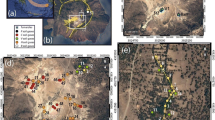Abstract
Soil-temperature measurements can provide information on the distribution of degassing fissures, their relationship to the internal structure of the volcano, and the temporal evolution of the system. At Vulcano Island (Italy), heat flux from a <3 km-deep magma body drives a hydrothermal system which extends across the main Fossa crater. This heat flux is also associated with variable magmatic gas flow. A high-density map of soil-temperatures was made in 1996 at a constant depth of 30 cm on the central and southern inner flanks of the Fossa crater. These measurements extended over an area covering about 0.04 km2, across which the heat flux is predominantly associated with a shallow boiling aquifer. The map shows that hot zones relate to structures of higher permeability, mainly associated with a fissure system dating from the last eruptive cycle (1888–1890). From 1996 to January 2005, we studied the evolution of the heat flux for the high temperature part of the map, both by repeating our measurements as part of 14 visits, during which temperatures were measured at a constant depth, and using data from permanent stations which allowed soil-temperatures to be continuously measured for selected vertical profiles. These data allowed us to calculate the heat flux, and its variation, with good precision for values lower than about 100 W m−2, which is generally the case in the study area. Above 100 W m−2, although the heat flux value is underestimated, its variations are recorded with an error less than 10%. During the period 1996–2004, two increases in the thermal flux were recorded. The first one was related to the seismic crisis of November 1998 which opened existing or new fissures. The second, in November 2004, was probably due to magma migration, and was associated with minor seismic activity.








Similar content being viewed by others
References
Aubert M (1999) Practical evaluation of steady heat discharge from dormant active volcanoes: case study of Vulcarolo fissure (Mount Etna, Italy). J Volcanol Geotherm Res 92:413–429
Aubert M, Alparone S (2000) Hydrothermal convective flux variation related to a seismo-tectonic crisis in the Fossa of Vulcano (Italy). CR Geosci 330:603–610
Capasso G, Favara R, Francofonte S, Inguaggiato S (1999) Chemical and isotopic variations in fumarolic discharge and thermal waters at Vulcano Island (Aeolian Islands, Italy) during 1996: evidence of resumed activity. J Volcanol Geotherm Res 88:167–175
Chiodini G, Cioni R, Marini L, Panichi C (1995) Origin of fumarolic fluids of Vulcano Island, Italy and implications for volcanic surveillance. Bull Volcanol 57:99–100
Chiodini G, Granieri D, Avino R, Caliro S, Costa A (2005) Carbon dioxide diffuse degassing and estimation of heat release from volcanic and hydrothermal systems. J Geophys Res 110:B08204. DOI 10.1029/2004JB003542
Diliberto I, Finizola A, Madonia P, Aubert M (2005) Convective heat flux from hydrothermal system: first monitoring results at La Fossa of Vulcano. Abstract Volume of the General Assembly IAVCEI Commission on the Chemistry of Volcanic Gases—9th Gas Workshop. Palermo, Italy, May 2005
Fortran Scientific Subroutine Library (1985) Wave-3.7. Software. Fortran Scientific Subroutine Library, Peerless Engineering, Burnaby, Canada
Granieri D, Avino R, Carapezza ML, Chiodini G, Ranaldi M, Ricci T, Tarchini L (2006) Correlated increase in CO2 fumarolic content and diffuse emission from La Fossa crater (Vulcano, Italy): evidence of volcanic unrest or increasing gas release from a stationary deep magma body? Geophys Res Lett 33:L13316. DOI 10.1029/2006GL026460
Hardee HC (1982) Permeable convection above magma bodies. Tectonophysics 84:179–195
Harris AJL, Maciejewski AJH (2000) Thermal surveys of the Vulcano Fossa fumarole field 1994–1999: evidence for fumarole migration and sealing. J Volcanol Geotherm Res 102:119–147
Harris AJL, Stevenson DS (1997) Magma budgets and steady-state activity of Vulcano and Stromboli. Geophys Res Lett 24(9):1043–1046
Hill DP, Pollitz F, Newhall C (2002) Earthquake–volcano interactions. Phys Today 55(11):41–47
Italiano F, Pecoraino G, Nuccio PM (1998) Steam output from fumaroles of an active volcano: tectonic and magmatic-hydrothermal controls on the degassing system at Vulcano (Aeolian Arc). J Geophys Res 103(B12):29829–29842
McKenzie D, Brune JN (1972) Melting on fault planes during large earthquakes. Geophys J R Astr Soc 29:65–78
Montalto A (1994) Seismic signals in geothermal areas of active volcanism: a case study from “La Fossa”, Vulcano (Italy). Bull Volcanol 56:220–227
Montalto A (1996) Signs of potential renewal of eruptive activity at La Fossa (Vulcano, Aeolian Islands). Bull Volcanol 57:483–492
Nuccio PM, Paonita A, Sortino F (1999) Geochemical modeling of mixing between magmatic and hydrothermal gases: the case of Vulcano Island, Italy. Earth Planet Sci Lett 167:321–333
Tabbagh A, Trezeguet D (1987) Determination of sensible heat flux in volcanic areas from ground temperature measurements along vertical profiles: the case study of Mount Etna (Sicily, Italy). J Geophys Res 92(B5):3635–3644
Ventura G, Vilardo G, Milano G, Pino NA (1999) Relationships among crustal structure, volcanism and strike-slip tectonics in the Lipari-Vulcano volcanic complex (Aeolian Islands, southern Tyrrenian sea, Italy). Phys Earth Planet Int 116:31–52
Walter TR, Amelung F (2006) Volcano-earthquake interaction at Mauna Laua volcano, Hawaii. J Geophys Res 111:B05204. DOI 10.1029/2005JB003861
Acknowledgements
This work was supported by EC Tekvolc contracts PL950250 and PL970584, as well as by a contract between M. Aubert and INGV, Sezione di Palermo. We warmly thank the two anonymous reviewers and Andrew Harris for their contributions which largely improved the previous manuscript. We would also like to thank J.-M. Barnagaud, S. Durand, V. Francofonte and M. Koyama for their help in the field; P. Madonia, A. Mastrolia and P. Ricobono for the improvement of equipment; S. Alparone for the communication of unpublished data regarding the seismic monitoring, the Geochemical Surveillance Functional unit, INGV Palermo, for communication of unpublished data, Frances van Wyk de Vries for correcting the English. This is IPGP contribution No. 2253.
Author information
Authors and Affiliations
Corresponding author
Additional information
Editorial responsibility: AJL Harris
Rights and permissions
About this article
Cite this article
Aubert, M., Diliberto, S., Finizola, A. et al. Double origin of hydrothermal convective flux variations in the Fossa of Vulcano (Italy). Bull Volcanol 70, 743–751 (2008). https://doi.org/10.1007/s00445-007-0165-y
Received:
Accepted:
Published:
Issue Date:
DOI: https://doi.org/10.1007/s00445-007-0165-y




